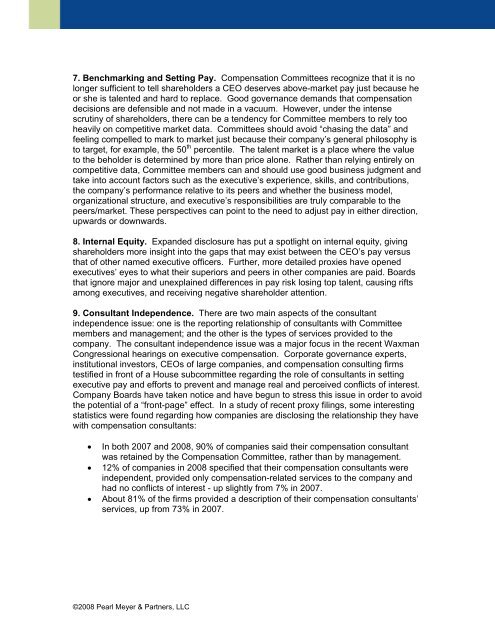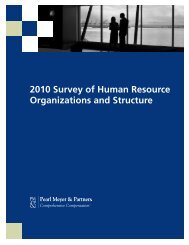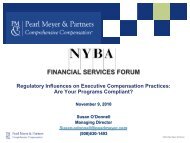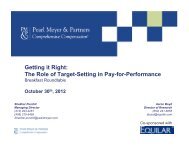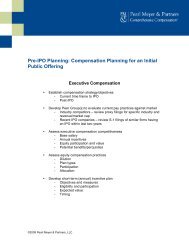Download - Pearl Meyer & Partners
Download - Pearl Meyer & Partners
Download - Pearl Meyer & Partners
Create successful ePaper yourself
Turn your PDF publications into a flip-book with our unique Google optimized e-Paper software.
7. Benchmarking and Setting Pay. Compensation Committees recognize that it is no<br />
longer sufficient to tell shareholders a CEO deserves above-market pay just because he<br />
or she is talented and hard to replace. Good governance demands that compensation<br />
decisions are defensible and not made in a vacuum. However, under the intense<br />
scrutiny of shareholders, there can be a tendency for Committee members to rely too<br />
heavily on competitive market data. Committees should avoid “chasing the data” and<br />
feeling compelled to mark to market just because their company’s general philosophy is<br />
to target, for example, the 50 th percentile. The talent market is a place where the value<br />
to the beholder is determined by more than price alone. Rather than relying entirely on<br />
competitive data, Committee members can and should use good business judgment and<br />
take into account factors such as the executive’s experience, skills, and contributions,<br />
the company’s performance relative to its peers and whether the business model,<br />
organizational structure, and executive’s responsibilities are truly comparable to the<br />
peers/market. These perspectives can point to the need to adjust pay in either direction,<br />
upwards or downwards.<br />
8. Internal Equity. Expanded disclosure has put a spotlight on internal equity, giving<br />
shareholders more insight into the gaps that may exist between the CEO’s pay versus<br />
that of other named executive officers. Further, more detailed proxies have opened<br />
executives’ eyes to what their superiors and peers in other companies are paid. Boards<br />
that ignore major and unexplained differences in pay risk losing top talent, causing rifts<br />
among executives, and receiving negative shareholder attention.<br />
9. Consultant Independence. There are two main aspects of the consultant<br />
independence issue: one is the reporting relationship of consultants with Committee<br />
members and management; and the other is the types of services provided to the<br />
company. The consultant independence issue was a major focus in the recent Waxman<br />
Congressional hearings on executive compensation. Corporate governance experts,<br />
institutional investors, CEOs of large companies, and compensation consulting firms<br />
testified in front of a House subcommittee regarding the role of consultants in setting<br />
executive pay and efforts to prevent and manage real and perceived conflicts of interest.<br />
Company Boards have taken notice and have begun to stress this issue in order to avoid<br />
the potential of a “front-page” effect. In a study of recent proxy filings, some interesting<br />
statistics were found regarding how companies are disclosing the relationship they have<br />
with compensation consultants:<br />
• In both 2007 and 2008, 90% of companies said their compensation consultant<br />
was retained by the Compensation Committee, rather than by management.<br />
• 12% of companies in 2008 specified that their compensation consultants were<br />
independent, provided only compensation-related services to the company and<br />
had no conflicts of interest - up slightly from 7% in 2007.<br />
• About 81% of the firms provided a description of their compensation consultants’<br />
services, up from 73% in 2007.<br />
©2008 <strong>Pearl</strong> <strong>Meyer</strong> & <strong>Partners</strong>, LLC


